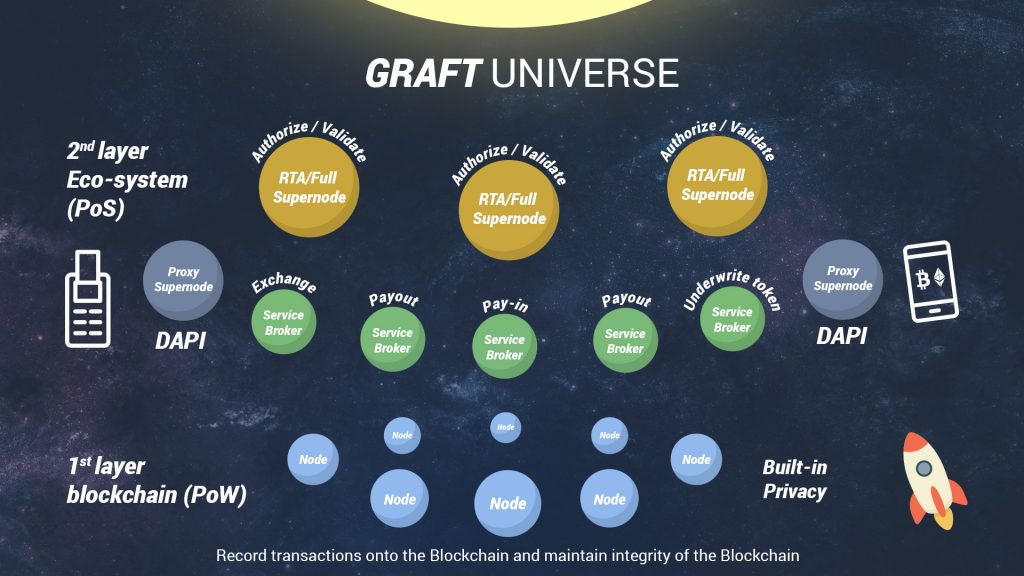Become a Part of GRAFT Ecosystem

YOU ARE THE NETWORK!

Consumer
Uses cryptocurrency to pay for goods and services. Can loan funds to others. Uses GRAFT wallet.

Merchant
Accepts alternative payments, offers loyalty programs, cashbacks*. Utilizes existing payment terminals, GRAFT POS app, or 3rd party integrations.

Merchant Service Provider
Provides payment network service to the merchants. Runs payment Gateway. Markets.

Full Supernode Operator
Validates and monitors off-chain transactions. Runs Full Supernode. Receives RTA fees. Download.

Proxy Supernode Operator
Maintains points of entry to the network. Runs Proxy Supernode. Receives Proxy SN fees.

Payout Token Underwriter.
Underwrites second-layer tokens including tethered payout tokens (“stablecoins”)

Developer
Develops applications that utilize network services via DAPI
REAL-TIME AUTHORIZATION (RTA) SUPERNODES:
Type of a node required: Full SuperNodeHardware / Systems Requirement: Minimum hardware requirements include dual core CPU with 8GB RAM. Scaling requirements will be published at a later date. The supernode has to be directly accessible from the Internet (public IP), preferably with low-latency, high speed network connection.
Functionality: Perform real time authorizations, validations, transaction holds.
Staking requirement: There are four tiers of supernodes based on the staking amounts, with equal fee distribution among the 4 tiers learn more
Incentive: Supernode owners collect fees for instant authorizations (roughly ⅛ of 0.5% of the transaction amount). Supernode selection is based on stake tiers: 50k/90k/150k/250k. See white paper for more details.
Steps: Authorization providers only have to install the Supernode and connect it to the staking wallet(s).
MERCHANT SERVICE PROVIDERS:
Type of a SuperNode required: Merchant Service Providers can either partner with the Proxy SuperNode host or host Proxy or Full SuperNode themselves.Hardware / Systems Requirement: Merchant Service provider will want to provide a Service Level agreement (SLA) to the merchant and as such should set up a high availability architecture for their SuperNodes.
Functionality: Merchant Service Providers provide important support and “gateway” services for the merchants, handling the set up, maintenance, and guaranteeing uptime for the network.
Staking requirement: Technically, a Merchant Service Provider doesn’t have to stake, however if the service provider chooses to host the Full Supernodes that also do authorizations, they will have staking requirements attached to those.
Incentive: Merchant Service Providers can add their own transaction fees on top of the network fees and/or have separate financial arrangements with the merchant. They can also distribute or lease payment terminals.
Steps: Setup Proxy or Full SuperNode infrastructure (or strike an agreement with the partner who will handle the technical operations part), define the business model (transaction fees, service fees, hardware distribution, etc), select the end-point strategy (payment terminals vs mobile POS/wallet solution), configure the end point to their SuperNode(s) as the gateway.
>
Hardware / Systems Requirement: Minimum hardware requirements include dual core CPU with 8GB RAM. Scaling requirements will be published at a later date. Exchange brokre has to be directly accessible from the Internet (public IP), preferably with low-latency, high speed network connection. Exchange brokers will most likely want to implement high availability and have a low-latency connection to a high speed network.
Note: We’re currently working with hosting partners to be able to provide turn-key hosting. Functionality: Exchange brokers provide crypto-currency and fiat exchange services to the network. These exchange services are used by the network for pay-in, pay-out, top up, broker-to-broker, and other types of exchanges and interchanges.
Staking requirement: While exchange brokers don’t have a “participation” stake, there is a minimum balance of 50,000 GRFT that has to be present in the GRFT exchange wallet in order for the exchange broker to be considered “online”.
Incentive: Exchange brokers stand to gain what will eventually be a high volume of exchanges originating in the network
Steps: Exchange broker software will be available soon. We’re also working on turn-key hosting and integration of the control interface via wallet.
Pay-out broker Sign up form Exchange Broker Calculator
EXCHANGE BROKERS
Type of software required: GRAFT Exchange brokerHardware / Systems Requirement: Minimum hardware requirements include dual core CPU with 8GB RAM. Scaling requirements will be published at a later date. Exchange brokre has to be directly accessible from the Internet (public IP), preferably with low-latency, high speed network connection. Exchange brokers will most likely want to implement high availability and have a low-latency connection to a high speed network.
Note: We’re currently working with hosting partners to be able to provide turn-key hosting. Functionality: Exchange brokers provide crypto-currency and fiat exchange services to the network. These exchange services are used by the network for pay-in, pay-out, top up, broker-to-broker, and other types of exchanges and interchanges.
Staking requirement: While exchange brokers don’t have a “participation” stake, there is a minimum balance of 50,000 GRFT that has to be present in the GRFT exchange wallet in order for the exchange broker to be considered “online”.
Incentive: Exchange brokers stand to gain what will eventually be a high volume of exchanges originating in the network
Steps: Exchange broker software will be available soon. We’re also working on turn-key hosting and integration of the control interface via wallet.
Pay-out broker Sign up form Exchange Broker Calculator
APPLICATION PROVIDERS
Type of a SuperNode required: Applications can run anywhere, but have to connect to a Full Supernode for DAPI.Hardware / Systems Requirement: Standard application availability / scalability considerations apply
Functionality: Opportunities abound for the application providers – device configuration and management, reporting and distributions, line of business applications, POS systems, integrations, etc, etc.. These applications can be distributed as software to run on Supernodes or be hosted by the developers as SaaS.
Staking requirement: Depending on the nature of an application a “bond” stake may be required to insure the funds that are taking off the network.
Incentive: Application providers are free to choose the business model that suits them – from software licensing including open source, to SaaS, to additional per transaction fees. In addition to supporting the application developers through a powerful distributed API (DAPI), GRAFT Blockchain Foundation is putting together a marketplace and will be awarding seed funds in GRFT to further incentivize application developers.
Steps: Application provider develops an application using DAPI to connect to GRAFT Blockchain and Service Network. Application provider can either include/host Full SuperNode to get access to DAPI, or connect to a available DAPI source.
MERCHANTS
Type of a SuperNode required: NONEHardware / Systems Requirement: Merchants have the following options at their disposal when it comes to enabling GRAFT Network payments at their location: Enable the existing payment terminal they are using (assuming it’s a compatible model) with GRAFT as an alternative payment method. To do this, they would download GRAFT app from the appropriate payment terminal’s marketplace (right now we’re actively working on support for Verifone and Ingenico). This way a merchant can use the same terminal for accepting traditional and crypto payments. Set up a separate terminal specifically for handling cryptocurrency payments. Use GRAFT POS if they don’t already have a POS / payment terminal setup or if they would like to start or shift exclusively to payments through GRAFT network.
Functionality: A merchant is able to start accepting cryptocurrency at their business without having to change processes, software, or retrain their staff. The merchant is further able to keep the funds in cryptocurrency or get instant or intermittent fiat payout.
Staking requirement: No staking is required for the merchant, however there are situations like accepting offline payments that might necessitate running a Supernode with a staking wallet on the point of sale system.
Incentive: The merchant is able to diversify their client base, appealing to crypto-owner demographic. The merchant gains an ability to have single payment processor for multiple locations, both off and online. Finally the merchant can consolidate their reporting, accounting, as well as facilitate fund distribution.
Steps: The merchant would need to contact the Merchant Service Provider to get set up, or they could set themselves up on GRAFT Network by download and running GRAFT POS application or install and configuring GRAFT Payment terminal application (in case of later they would also need to either host their own Proxy supernode or find a proxy Supernode provider)
REGIONAL BOARDS
GRAFT Network does not have centralized governance, but the at the local levels we believe there should be layers of local activism / oversight to bring the network to full local scope and monitor quality.These groups are free to establish their own ground rules and processes and their own business models. One such model can be represented by a membership dues organization that certifies and shares best practices among its members, facilitating merchant adoption and providing a support system for the merchant providers.
Graft Economics













